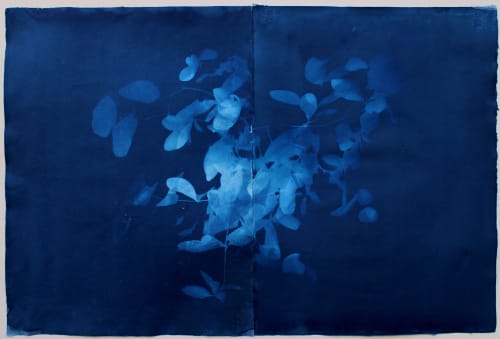Originally from the Kootenays in British Columbia, Loren Williams moved to Montreal in 1993 and received her BFA honours in photography at Concordia University. She has received awards and grants from the federal and provincial art councils and has exhibited her work nationally with solo and group exhibitions in galleries, museums and various unconventional exhibition sites including cemeteries, parks, a laneway, a front door peephole, a pharmacy and a train station. Recent artist residencies and their connected exhibitions include the Osler Library for the history of Medicine, McGill University, Montreal (2017-18); Adélard immersive artist residency, Frelighsburg, QC. (2020); Artneuf, Park Lafontaine, Montreal (2022).
---
"I am a Montreal-based artist interested in natural history and early photographic processes. My working methods borrow from the fields of archaeology, botany, museology and other forms of collecting and salvage. My work is often site-specific with strong connections to local history.
I began using the cameraless Cyanotype photo process in 2000, spending the summer working with a museum bird collection. To the bewilderment of people standing outdoors nearby, I would exit the museum with a large bird specimen lying on top of my light-sensitive paper. I'd look up at the sun to get the best light orientation, look at my watch, wait the required 5 -10 minute exposure then return inside with the bird to complete the cyanotype image, making it permanent with water. It felt like an odd kind of performance, something alchemical. Years and many projects later, I still feel this sense of wonderment, conjuring unpredictable images out of light, shadows, water and time.
Much of my recent work is connected to botanical and historical aspects that intersect with present day sites. In Search of the Papineau Woods a site specific installation in Park Lafontaine, Montreal, invited viewers to wander through the park and through time, discovering painted images of plants that existed 200 years earlier when the park was a lush woods crisscrossed by small rivers. The ground level images in the installation were visible only when it rained or when water was poured on the different sites by viewers. The work was inspired by an early 19th century catalogue listing plant specimens collected in 1821-22 on the island of Montreal including a site called the Papineau Woods, which today is Park Lafontaine.
In the exhibition Boisé bleu I continue to explore the park and early woods reflecting on nature and time through the mediums of a cameraless, cyanotype photo process and with ephemeral images revealed with water. The cyanotype images were created from collected, natural materials as well as created on-site in the park from the shadows of living plants falling on the light sensitive surface of my paper. As in the recent Park Lafontaine installation, botanical images on concrete forms were created specifically for this exhibition. The images become visible when sprayed with rainwater. They disappear as the surface dries and reappear when wet. Together, the works form a type of shadow herbarium.
Suggestive of watery pools and dark blue skies, the deep blue coloured cyanotypes reflect these vantage points for discovering nature by looking down as well as gazing at the night sky. A luxury of stars, is a cluster of small, painted images of quartz and other minerals. The images reference geological aspects connected to the Park Lafontaine site. The luminous shapes painted on a dark cyanotype background also allude to stars in the night sky overhead and reflect my awe that the light from stars so far away are views of the past, billions of years ago. Artworks entitled Linden Constellation refer to the round seeds of tall Linden trees growing in Park Lafontaine. The fallen seeds were collected to create the cyanotype prints where their shadows remain, contained within the limits of the paper, resembling both microscopic views and celestial constellations.
Situated steps away from Park Lafontaine and with its own hidden, natural outdoor space, the gallery and the Boisé bleu artworks offer an echo and an ode to the park and early woods."
